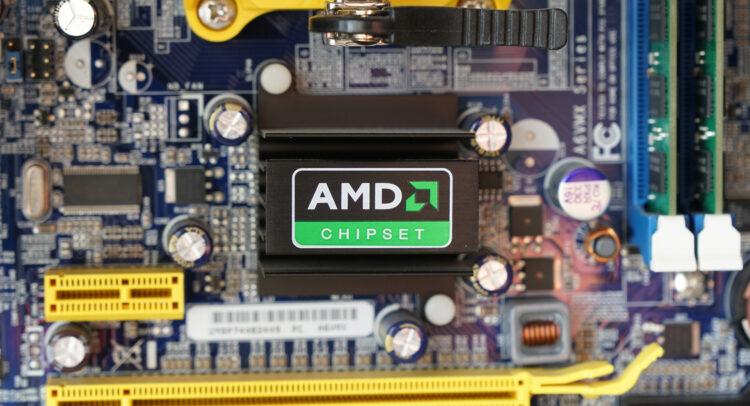Advanced Micro Devices (NASDAQ:AMD) is a fabless chip designer that designs semiconductors. AMD stock has soared due to speculation around AI and the potential for improved earnings, but I’m bearish on the stock because I think its $335 billion valuation is exorbitant, especially when one considers the risks. There are worrying signs both externally and within AMD.

A Goodwill Monster after Huge Acquisition
At the beginning of 2022, AMD acquired Xilinx for approximately $50 billion, valuing the company at 16x sales. As a result, AMD now has $24.3 billion of goodwill and $21.4 billion of acquisition-related intangible assets on its balance sheet. AMD paid an enormous premium above the value of Xilinx’s physical assets. This typically doesn’t end well. You see, if Xilinx’s earnings don’t live up to the price AMD paid, AMD will have to write down the value of Xilinx and take a huge loss on its income statement.
Also, if we subtract the above intangibles from AMD’s shareholders’ equity, the company has just $10.3 billion of tangible equity. This makes AMD’s $335 billion market cap look like it’s full of air.
Competitive Threats
When a company earns large profits on assets that wouldn’t cost much to replace, it attracts competitors into the space. Recently, Amazon (NASDAQ:AMZN), Microsoft (NASDAQ:MSFT), and Apple (NASDAQ:AAPL) have been working on developing their own semiconductors, and they have a lot of capital to do it. Apple has hindered AMD’s profitability in the PC market, and Amazon and Microsoft could hinder Data Center profitability in the years ahead. I expect that competition will only worsen for companies like AMD, Intel (NASDAQ:INTC), and Nvidia (NASDAQ:NVDA).
China and Geopolitical Risks
AMD designs chips, but it doesn’t manufacture them. For that, AMD relies on Taiwan Semiconductor (NYSE:TSM). AMD stated:
“We utilize third-party wafer foundries to fabricate the silicon wafers for all of our products. We rely on Taiwan Semiconductor Manufacturing Company Limited (TSMC) for the production of all wafers for microprocessor and GPU products at 7 nanometer (nm) or smaller nodes.”
2023 AMD Annual Report
The problem is, China views the country/island of Taiwan as its own. Taiwan values its independence and democracy above all else. Therefore, China has been amassing enormous military power and threatening Taiwan constantly with fighter jets and military exercises. TSMC’s entire operation is currently based in Taiwan, and it has delayed the opening of its U.S. operation to 2027 or 2028.
If a conflict were to disrupt the Taiwan fabrication plants, it would be devasting for AMD. Who would manufacture its world-class chips? While I hope this doesn’t happen, and I assign it a relatively low probability, the potential devastation is not baked into AMD’s share price.
Did I mention that AMD had 15% of its sales in China last year, and the U.S. is restricting the sale of advanced chips to China (likely to limit China’s military capabilities)? This just doesn’t seem to be priced in at 15x sales and almost 400x earnings.
People Are AMD’s Key Moat
I believe that in technology, especially the fabless semiconductor space, people can provide a competitive advantage. Why did Nvidia and AMD gain ground against Intel? It probably had a lot to do with their people. Executives, board members, and employees really matter, but these same people can easily walk out and work for a competitor. Thus, AMD has to pay them a lot of money.
But how does AMD pay its employees huge sums without eating into its cash flows? Three words: stock-based compensation. Not only does this not eat into free cash flow, but AMD also adds stock-based compensation back when calculating “non-GAAP operating income.” The problem, of course, is this is a real expense that dilutes shareholders.
AMD has averaged $2.5 billion of free cash flow over the past three years, but subtract the average stock-based compensation of $0.95 billion, and you get a three-year average earning power of $1.55 billion. With a $335 billion market cap, the company trades at 216x this amount. Will the future be better than the past? The market sure seems to think so.
Is AMD Stock a Buy, According to Analysts?
Currently, 28 out of 34 analysts covering AMD give it a Buy rating, six rate it a Hold, and zero analysts rate it a Sell, resulting in a Strong Buy consensus rating. The average AMD stock price target is $201.26, implying downside potential of 3%. Analyst price targets range from a low of $140 per share to a high of $270 per share.

The Bottom Line on AMD Stock
AMD’s risks are not priced in. Geopolitical risks around China and TSMC have elevated over the past few years, but the market is ignoring the implications when it comes to companies like AMD and Nvidia. Moreover, there is a high probability that AMD overpaid for its acquisition of Xilinx, which could result in future write-downs/losses.
With just $10.3 billion of tangible equity and a $335 billion market cap for AMD, I think competitors will be drawn into the semiconductor space. Big tech is already getting in on the action.
Lastly, after subtracting stock-based compensation, AMD makes very little money relative to its enormous market cap. These factors make AMD stock appear risky at its current price.









